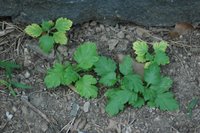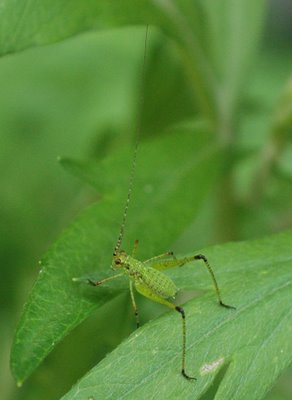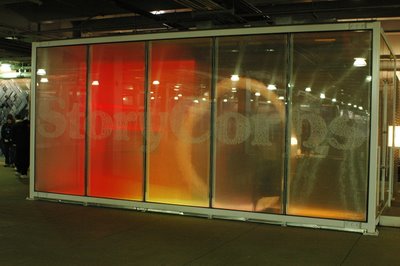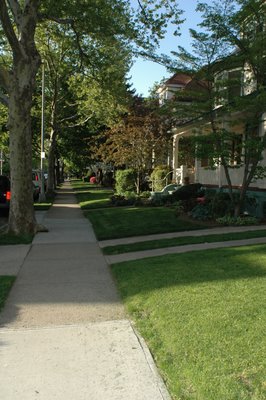I'm writing this from my tree fort. Actually, it's the rear porch on the second floor of our house, roofed and screened (mostly). Seated at the table here, my line of sight is about 17 or 18 feet from ground level.
It's dusk. Most of the birds have settled in for the night. I hear, but can't see, a cardinal calling out from high in a neighbor's tree. To my left is our next door neighbors' apple tree; its apples are showing color now, so maybe we'll have
parrots at the end of the summer again like last year. In front of me, in our backyard, are two Norway Maples towering overhead and our flowering cherry tree barely reaching my eye-level. Behind us, our back neighbor has another flowering cherry. On the other side of us, to my right, our other next door neighbor has in their backyard a cedar, a spruce, a dogwood, and something else I don't know. Behind them is a birch. Beyond, more distant and all around, are more maples, oaks - everything.
This neighborhood is
all about its trees. Our lot is 50' wide at the street and 100' deep, like most of the lots in this area. For New York City, that's huge; most townhouses are 20' wide or less. The houses are fully detached, wood-frame homes built at the turn of the last century, mostly late Victorian in style as ours is. No two of the houses are exactly alike. From up here on the back porch, you can see nearly every style of roof and dormer: shed, gable, hipped, gambrel, and eyebrow.
This leaves lots of room for trees, and gardens. Here, at my fourth garden in New York City, for the first time I can have multiple gardens: front, back, and two sides. I've watched and weeded and planted and watered them over the year since we moved in. My ideas for them, for what they will all become, have shifted a little over the past year.
The front yard faces West. It's shaded by street trees for much of the day during the summer, which limits the varieties I can grow there. There is a sunlight gradient from the south side of the front yard, which is open and sunnier, to the north side, which is more shaded. There is also a small lawn. When we first moved, I thought I would eliminate it. But when I walk along the sidewalk on our block, I see the arbor of trees along the street on one side, and the sweep of lawn uniting the properties on the other. It is a parklike setting, and when this view is interrupted by hedges, walls or fences, I miss it. To preserve this, I can live with a little bit of lawn.
The front yard will be the heirloom/antique garden. All the plants there will be species and varieties which were available over 100 years ago, 1905 or earlier. Our house was built in 1900, so this is the "Neo-Victorian" garden referenced in this blog. No elaborate bedding plant schemes or anything like that. There will be heirloom bulbs, perennials, annuals, a shrub or two, and at least one
old rose. Victorian gardeners were eclectic, fascinated with the new and bizarre, while embracing the old-fashioned and comforting. Which describes me pretty well.
On the south side of the house is the driveway. During the summer, the sun is high enough to clear even the three stories of our next door neighbor's house. The bed along this side of the house gets full sun. It runs nearly the depth of the house, for 35 feet or more. Its width varies: it's about 8' at the deepest and tapers to a point at the rear corner of the house.
This will be the cutting garden, the rough garden, the wild garden ... the garden for anything I want to grow that doesn't fit anywhere else. This will be a mixed border. Variations in height, color and texture will make the beds seem longer, and deeper, than they actually are. There will be a place here for at least one other old rose and some other shrubs. There's enough room here for them to grow large enough to partially shade the first floor of the house and keep it cooler in summer, while allowing sun in the winter to warm it. These will also visually anchor the house to the property, connecting it to the land and making it seem smaller than it is.
(I've moved inside for the rest of this. It got chilly and started raining as it got dark outside.)
The backyard will be a sanctuary garden, for people and wildlife. It will be separated from the side yard and driveway by a fence and gate. Visitors will pass through a deep trellis, providing a transition to mark the entry into the sanctuary. Vines on the trellis will shield the backyard further, providing a feeling of enclosure and reinforcing the sanctuary.
There will be seating back here, and a porch swing suspended from another trellis. The backyard will be all native plants (save for the Norway Maples, about which I can do little for now). I've had bird feeders up, but these attract junk birds - European finches, starlings, even the occasional pigeon - as well as native species. So I'll be planting the native shrubs I've collected over the years. The tallest will grow up to 15' in time, providing an understory. These will provide berries as well as shelter, and possibly nesting sites. At ground level there will be ferns and wildflowers. There will be a mix of things growing from the ground up into the lowest reaches of the canopy provided by the trees.
The north side of the property is narrow, maybe 6' wide. Native plants, especially ferns, will continue onto this side of the house. There will also be other shade plants: hostas, astilbes, and so on. A narrow path will lead to another gate and trellis to demark the transition between the backyard sanctuary and the front, public side of the property. On the front side of the gate will be more shade plants, merging with our next door neighbor's mixed bed along their driveway, blurring the line between the two properties. The path continues to the front of the house, to the front steps, and back to the heirloom garden.
While I could walk around the property in a minute or two, all these transitions, shielded views and sheltered places, changes in designs and textures, and the sheer number of different species of plants all have a larger purpose. I want visitors, and me, to slow down, to view, to feel, to smell, to listen to the gardens. The gardens will invite us to stretch out time and space, to connect, however briefly, with other rhythms and beats. The gardens will allow us to synch with the pace of the minute, the day, the seasons, the years.
It will take years to accomplish all this. But I'm hoping to be here a long while. I hope that things will be in good enough shape in two years that I can add my gardens to the
Victorian Flatbush House and Garden Tour. Visitors to this blog will be able to watch my progress over the next two years. And if I get on the tour, you'll be the first to know.










